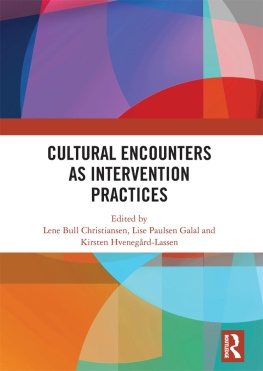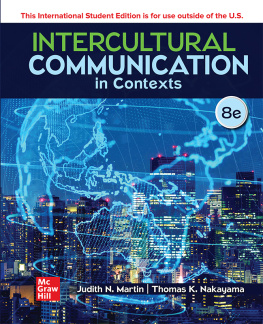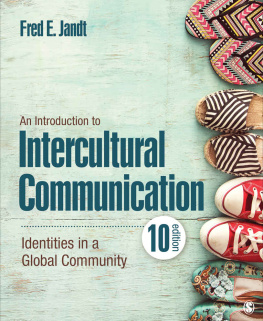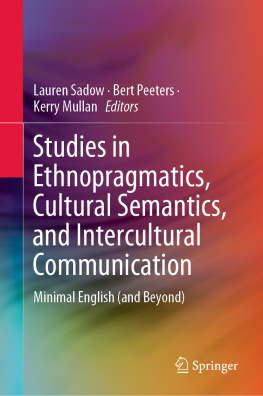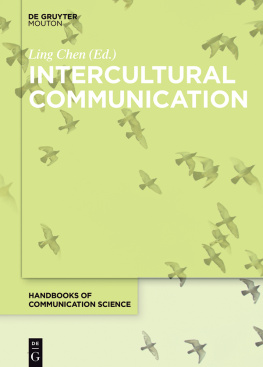Experiential Activities for Intercultural Learning
Experiential Activities for Intercultural Learning
H. Ned Seelye editor

First published by Intercultural Press, a Nicholas Brealey Publishing Company, in 1996. For information, contact:
Intercultural Press, Inc.,
a division of
Nicholas Brealey Publishing
Hachette Book Group
53 State Street
Boston, MA 02109, USA
Tel: (617) 523-3801
www.interculturalpress.com
Nicholas Brealey Publishing
Carmelite House
50 Victoria Embankment
London EC4Y ODZ
Tel: 020 3122 6000
www.nicholasbrealey.com
1996 by Intercultural Press
ISBN-13: 978-1-473643-71-0
eISBN: 978-1-94117-606-1
ISBN-10: 1-877864-33-1
Printed in the United States of America
15 14 13 12 11 11 12 13 14 15
Library of Congress Cataloging-in-Publication Data
Experiential Activities for Intercultural Learning / H. Ned Seelye, editor.
p. cm.
Includes bibliographical references.
ISBN 1-877864-33-1
1. Multicultural education-United States-Activity programs. 2. Interpersonal communicationUnited States. I. Seelye, H. Ned
LC1099.3.E97 1996
370.196-dc20
95-36960
CIP
Table of Contents
H. Ned Seelye
Sheila Ramsey
Gary R. Smith and George G. Otero
Ann Hubbard
Thomas Baglan
Jane Stewart Heckman, Mary J. H. Beech, and Louise Munns Kuzmarskis
Ruth Lambach
Indrei Ratiu
Donald W. Klopf
Jorge Cherbosque
Sandra Tjitendero
L. Robert Kohls
Donald Batchelder
Indrei Ratiu
Anne B. Pedersen
Linda B. Catlin and Thomas F. White
Ann Hubbard
Donald W. Klopf
Judith M. Blohm
Donna L. Goldstein
Judith M. Blohm and Michael C. Mercil
Carol Wolf
Donna L. Goldstein
Paula Chu
Ellen Summerfield
Mary D. Imanishi
Elijah Lovejoy
Elijah Lovejoy
Elijah Lovejoy
Margaret D. Pusch
James Baxter and Sheila Ramsey
Judith M. Blohm
Cornelius Grove
J. Daniel Hess
Introduction
H. Ned Seelye
The Antecedents
Intercultural communication has piqued the interest of trainers, teachers, and scholars in a number of disciplines for some time, although this focus has always been peripheral to the central concerns of their respective academic guilds. More likely than not, they labored in ignorance of what their colleagues in other disciplines and in other organizations were doing to enhance the intercultural skills of students or workshop participants.
One early effort to exchange information was made by David S. Hoopes and Toby S. Frank under the aegis of the Intercultural Communications Network. The Network gathered and informally distributed cross-cultural training materials, intercultural communication course syllabi, and other writings through a now out-of-print series, Readings in Intercultural Communication. Teachers and trainers were asked what objectives they were pursuing, how they organized their training, and what resources they used. The Network also published Intercultural Sourcebook, a more systematic survey of cross-cultural training techniques and methodologies, which was another useful vehicle for sharing ideas. This, too, was out-of-print, and Volume I of what will be a two-volume set has recently been reissued, in an extensively revised and expanded edition, by the Intercultural Press, edited by Sandra M. Fowler and Monica Mumford.
The formation of a common meeting place for these colleagues occurred in 1975 with the birth of SIETAR, the Society for Intercultural Education, Training and Research (which later became SIETAR International). The first SIETAR conference twenty-one years ago was fascinating in its human dynamics. Many professionals discovered they werent the only peacock on the lawn, that other colleagues had pretensions of deep (and somewhat exclusive) expertise in things cross-cultural, and that the ideas of their colleagues often sharply differed from their own. This did not necessarily brighten their day. In one large conference session, an American psychologist rose from the floor to talk about ego strength, only to have his own tested by a participant from India who immediately rebutted the American by saying that in many Eastern societies there is no I apart from the rest of the universe of people and things. And so it went for several contentious but enormously stimulating days. Ruffled feathers were smoothed by the prevailing eagerness to learn; subsequent meetings have been characterized by an easy acceptance of others and an interest in novel ideas.
Practical-minded trainers and teachers sometimes fidget during long discussions of the many (more than twenty to date) theoretical constructs underpinning cross-cultural training. (An excellent source for many of these discussions is the International Journal of Intercultural Relations.) Give me something practical to use next week, teachers and trainers pleaded.
Early attempts to respond to this call resulted in Guidelines for Peace Corps Cross-Cultural Training (1970); A Manual of Teaching Techniques for Intercultural Education (1971); and the first book to suggest a specific cross-cultural learning methodology, along with illustrative activities for foreign language teachers, Teaching Culture (1974; its revised editions are aimed at intercultural teachers and trainers from any field). Three colleagues provided teachers and trainers, in 1977, with A Manual of Structured Experiences for Cross-Cultural Learning. They modeled the general format of their book on a series published by University Associates (now Pfeiffer & Company) for organizational development and human relations trainers.
The Current Volume
This volume, the first in a projected series, provides teachers and trainers on the front lines with a provocative essay that discusses both theory and practice, followed by thirty-two practical activities to engender understanding and skill in one facet or another of intercultural contact. Just being practical, of course, is not enough. The activities selected for this series also are purposeful and economic. That is, they are aimed at parsimoniously advancing a cross-culturally relevant objective.
We try to give parental credit to the creators of the activities included in this series, but the genesis of many training activities is hard to pin down. Many activities are anonymously authored, others are borrowed or retold by trainers who fail to footnote the prior authorship, and most of the activities are edited by hundreds of practitioners (who may feel the activity is now theirs). Everyone who uses an activity tends to salt it liberally to his or her own taste. Many of the activities originators are not so much parents as godparents. The editor of this series has himself further edited many of the activities selected for this volume; you, reader, are invited to continue the evolutionary process.
Current Strengths and Weaknesses
The up side of the current state of the art regarding intercultural training activities is that there have evolved over the last twenty or thirty years-and are available in books-hundreds (but not thousands) of mostly discrete experiential learning activities. Most of these have been designed and used by American trainers and teachers who face largely American trainees; generally they aim at short-term adjustment to a country the trainees have not visited. Most of these activities are designed to allow adolescent and adult learners to discover that there are special skills needed to communicate across cultural boundaries. A few even go beyond awakening awareness to developing some handy skills. A few of the activities are simulations that allow the participant to experience a measure of what it feels like to be in an intercultural situation. The vast majority of the activities focus on understanding that is culturally general in nature. No matter where a participant is headed, geographically speaking, he or she profits from greater awareness of the principles governing accurate communication, rapport, and persuasion in foreign settings.
Next page

